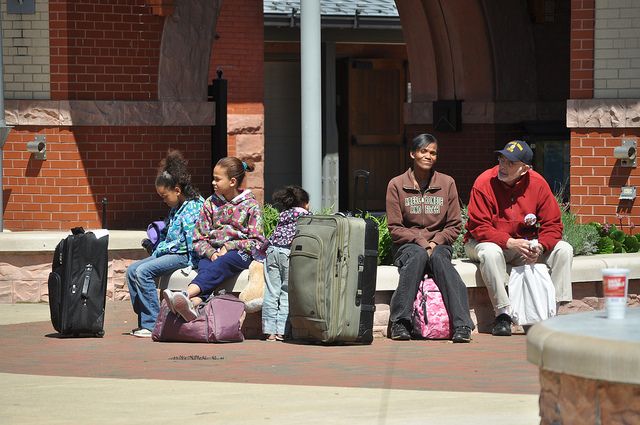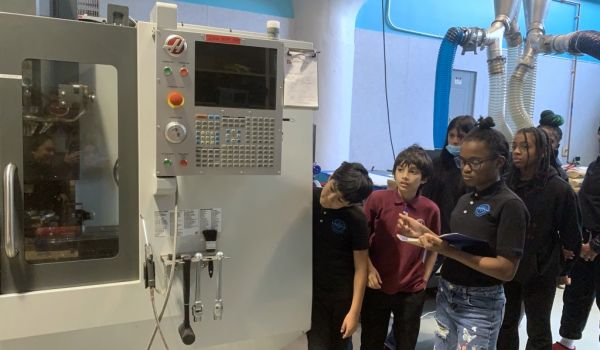Even as college-readiness is touted as the measure of high school success, college itself is becoming so pricey that few but the wealthiest students (and poorest, who qualify for automatic grants) can attend. At state colleges around the country, annual in-state tuition and fees can run to $10,000 and up. And this school year, the federal government tightened its Pell Grant rules, making it difficult for many low-income students to get subsidies for college.
So stories about compensatory programs like the Kalamazoo Promise, detailed in this week’s New York Times Magazine, are particularly heartwarming. Anonymous donors banded together in 2005 to start a fund that promised all Kalamazoo high school graduates free tuition at Michigan colleges and universities. The article quotes students and parents breaking into tears at the announcements coming over the school PAs.
“My classmates started crying,” Xochitl Gonzalez says. “I cried, too. It seemed unreal. Before the announcement, a lot of my classmates weren’t going to go to college. Afterward, everyone applied.”
Yet the fund’s goal is not merely to help students continue their studies and enter the permanent middle class through education. It also hopes to rebuild the city through investing in its young residents. Students get their entire tuition covered if they stay in Kalamazoo schools from kindergarten through graduation; if they enter by freshman year, they get 65 percent covered; later than that, they are not eligible.
The program encourages families to stay in Kalamazoo and in its public school system, regardless of income. It’s an all-in bet, binding the community around the central tenet that more education is good for all. “The Promise donors saw how a school district in decline and a weakening economy created a vicious circle,” writes the Times’ Ted C. Fishman. “Poor schools hindered Kalamazoo’s ability to support businesses and bring in new ones, and as commercial activity suffered, the resources available to schools shrank.”
Since the pledge, in fact, test scores have gone up in the high schools, graduation rates have climbed, and 90 percent of graduates enter college. Families that once considered moving stay put — and invest in the schools and broader community.
This seems like a worthy program that struggling smaller cities around the country would want to adopt, provided they can track down some deep-pocketed local education philanthropists more interested in graduation rates than teacher evaluation. And several, such as Pittsburgh and New Haven, have begun the attempt.
Not all cities can muster an array of anonymous private donors indefinitely, though. They shouldn’t have to, either. We pay taxes for that.
The Kalamazoo carrot — covered tuition at college — is unnecessary in many other countries. In most of continental Europe (as well as India, Iran, Israel, Costa, Rica and Singapore) college is free, with costs covered through a mix of federal, state and European Union funds (although students in Germany recently have been outraged at having to pony up for minor “fees”). The result is that high school students, on the whole, compete to get the grades to get them into various college programs, which are more crowded in the well-compensated professions such as medicine and law.
Years ago, American state colleges, too, were within reach. Like the rest of my family older than 50, my father attended the University of California. In 1960, UCLA cost between $54 and $75 a semester for full-time (depending on whose Boomer memory you want to rely on), while the junior college he started off in was $6.75 — for the entire semester. Working your way through college, and actually finishing it, was possible for the majority of poor and middle-class students.
The reasons for rising costs are complex, especially in California, and demand is huge: There are more numbers of students heading to college than ever, even if the majority of those who start never finish. A 2011 Harvard study found 56 percent of college students finished four-year degrees within six years, while 29 percent of those pursuing two-year degrees finished within three years. At for-profit four-year schools, 78 percent of matriculates don’t graduate in six years.
But the underlying hypocrisy today is simple: Policymakers identify the mark of a successful high schools as the number of its “college-ready” graduates. But they are loathe to make those colleges truly public, expecting students to pay fees to banks on their loans and then blaming these new low-wage workers when they default on their loans.
College today exists as a metonym for access to the American Dream. The Kalamazoo donors made that figurative association very real. Fulfilling the “promise” meant reaching into all the dark corners of a crumbling city and brightening them with, ultimately, better early childhood care, community health care, and outreach energized “promise” itself.
Many of the students from Kalamazoo who enrolled in college drop out, like their co-eds countrywide, and not all return to Kalamazoo to work and live. Still, the population drain was halted, and the schools themselves got better. As the past glories of our state systems and the current open access of Europe’s universities show us, funding for all can work on a broad scale. Expanding the Kalamazoo Promise could work across the country, when states invest in their college students again.
To benefit localities and funders long-term, however, two stringent criteria may need to be taken seriously. One: student quality. Funding is contingent on getting in, and admission should be based on the expectation that the student can do the work, rather than pay the fee (see the dismal record of for-profit colleges, above). Two: community counts. State-funded colleges could require residency for two years after graduation as well, keeping all those newly enriched brains close to the towns that trained them.

Carly Berwick writes about education and culture for Next City, as well as The New York Times, ARTnews, and other publications.










